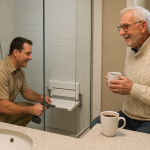I’ve spent years helping families navigate the journey of aging in place. One thing I see over and over is how one simple addition can transform a home from risky to secure. Grab bars for seniors are one of the most effective tools for creating a safe, independent home.
One in four older adults will experience a fall each year which makes them the leading cause of injury among seniors. Though, I’ve also seen how the right safety measures can prevent these accidents. When it comes to grab bars, they do more than prevent falls. They restore confidence and preserve the dignity that comes with independent living.
“Grab bars can help maintain independence while reducing the risk of falls and costly emergency room visits.”
When I talk with adult children of aging parents, they often feel overwhelmed by safety concerns. Installing safety bars offers an immediate, affordable solution that provides peace of mind for the entire family.
What Are Grab Bars and How Do They Help?
Grab bars are sturdy, wall-mounted devices designed to provide stability and assistance during daily activities. Unlike decorative towel bars or furniture, these specialized safety bars can support substantial weight—typically a minimum of 250-pounds (114-kg) when properly installed.
Grab bars can serve multiple purposes such as:
- “Providing support during transfers (getting in and out of the shower)”
- “Aiding balance when walking or using stairs”
- “Replacing unsafe habits like grabbing towel bars or furniture”
The individuals who benefit most include:
- “Seniors with balance issues”
- “Individuals with arthritis”
- “People recovering from illness or surgery”
Nevertheless, I always recommend that families consider installation before problems arise. Proactive planning is more effective than reactive measures after a fall occurs.
These safety devices must meet ADA compliance standards, ensuring they can withstand significant force. Consequently, proper installation becomes critical for effectiveness and safety.
Types of Grab Bars
Wall-Mounted Grab Bars
Wall-mounted grab bars for seniors represent the gold standard for bathroom and home safety. These permanently installed devices offer maximum stability and durability and are recommended for high-use areas near showers and toilets. They also come in various lengths and finishes to match existing bathroom décor. Textured or knurled finishes are also available for better grip under wet conditions.
Suction-Cup Mounts
Suction grab bars for showers provide temporary or light-duty use at best—usually for renters or those visualizing placement options. However, I must emphasize to use caution with these devices. While convenient, they don’t offer the same reliability as permanently mounted grab bars for seniors.
Flip-Up Models
A flip-up grab handle works brilliantly in tight bathroom spaces. These ingenious devices fold against the wall when not needed, maximizing accessibility. They’re a great option for households shared by seniors and younger family members.
Angled and Corner Grab Bars
Angled grab bars for seniors provide ergonomic support during transitions. These specialized bars follow the natural arc of movement when sitting or standing. Corner-mounted versions work particularly well in shower enclosures where space is limited.
Floor-to-Ceiling Transfer Poles
Transfer poles extend from floor to ceiling without requiring wall mounting. These vertical stand-alone models work well in bedrooms and living rooms. They’re also ideal for rental properties where permanent installation isn’t possible.
With so many grab bar designs available, it can be hard to know which one fits best. This chart breaks down the main types of grab bars and where they’re most effective.
| Type of Grab Bar | Best Use Location |
|---|---|
| Wall-mounted grab bars | Bathroom (showers, toilets), hallways |
| Suction-cup grab bars | Temporary setups, travel, rentals |
| Flip-up grab bars | Compact bathrooms, shared spaces |
| Angled/corner grab bars | Showers and bath enclosures |
| Floor-to-ceiling transfer poles | Bedrooms, living rooms, beside beds |
Room-by-Room Placement Guide
Strategic placement throughout the home ensures comprehensive safety coverage.
“We hadn’t installed grab bars in my mother’s home—for all the familiar reasons. She didn’t see herself as old, and truthfully, neither did we. Maybe we were avoiding what it meant to accept that part of aging. I’m not sure. But after she passed away from a fall in her bathroom, that hesitation haunted me. It’s why I now believe in acting early, not after something happens.”
Grab Bars for Bathroom
Grab Bars for Shower and Tub Areas
I suggest installing bars both inside and outside the shower entrance. Horizontal shower safety bars along the back wall provides stability while washing. While a vertical bar near the shower controls offers support when reaching for faucets or shampoo.
Bar supports should also be placed both where you enter and exit the tub. A grab handle provides the most natural grip angle when stepping over the tub edge. You could also consider a long horizontal bar along the tub’s back wall for seated bathing support.
Toilet Area Support
Toilet grab bars can be installed horizontally or vertically, depending on individual needs. I often suggest both a horizontal bar for sitting and standing assistance, plus a vertical bar for additional balance support. Toilet rails should be positioned 33-36 inches from the floor for optimal accessibility.
Bathroom Entrance Support
Installing grab bars for seniors near the bathroom entrance helps with the transition from hallway to potentially slippery bathroom surfaces. This placement is especially valuable during nighttime bathroom visits.
Hallway and Stairway
Hallway Support Systems
Long hallways benefit from grab rails or continuous support bars, especially in homes where balance issues are a concern. I suggest installing them at standard handrail height, or 34-38 inches, along one wall. Moreover, ensure adequate lighting accompanies these installations.
At hallway corners and turns, bar supports are crucial for safely enabling directional changes. These transition points often catch seniors off-guard, making support rails essential.
Stairway Grab Bars
Staircases require grab bars for seniors at both the top and bottom landings. Additionally, continuous handrails along the entire staircase provide ongoing support. Stairway support bars must be securely mounted to wall studs due to the extra force applied during stair navigation.
In the Bedroom
Bedside Support
Bedroom grab bars typically take the form of transfer poles or wall-mounted bars beside the bed. These devices provide essential support when getting in and out of bed, particularly during nighttime bathroom trips. Floor-to-ceiling poles work exceptionally well because they don’t require wall mounting.
I suggest positioning grab bars on both sides of the bed when space permits. This arrangement ensures support regardless of which side the senior exits the bed. This can also be invaluable for individuals with arthritis or joint stiffness that’s typically worse in the morning.
Bedroom Entrance Areas
Installing support bars near bedroom doorways helps with transitions between rooms. These placements prove particularly useful for seniors who use walking aids such as rollators.
“We tend to overlook the inconveniences that come with owning pets, and maybe that goes for the challenges and risks as well. I have heard from several seniors that grab bars placed near the entrance to the home provide extra stability and overall confidence—especially when dealing with a rambunctious pet on a leash.”
Entryway Grab Bars
Front and back door areas benefit greatly from support bars. Installing them both inside and outside these entrances provides support when navigating steps or threshold transitions. They also prove to be useful when carrying groceries or packages.
I suggest combining bars in the entryway with improved lighting and non-slip surfaces. This comprehensive approach creates a safer entrance experience. You should also consider the visual appeal—today’s grab bars come in attractive finishes that complement home décor.
Grab bars aren’t just for bathrooms—they can be placed throughout the home to make daily routines safer. Here’s a room-by-room guide to the most effective placements.
| Room | Recommended Placement | Purpose |
|---|---|---|
| Bathroom | Shower walls, near tub, beside toilet | Prevent slips during hygiene tasks |
| Hallways | Along walls, at turns or corners | Maintain balance while walking |
| Stairways | Top/bottom landings, continuous handrail | Support while climbing or descending |
| Bedroom | Beside bed, at doorways | Support when getting in/out of bed |
| Entryways | Near interior and exterior doors | Assist when entering, exiting, or carrying items |
Thinking beyond the bathroom ensures seniors have steady support wherever they need it most.
When Is the Right Time to Install Grab Bars?
Recognizing the best time to install grab bars can prevent serious injuries and maintain independence.
After a Fall or Close Call
Following any fall or near-miss incident, I strongly suggest immediately installing grab bars for seniors. These events often signal declining balance or strength. It’s always wise to act before an accident occurs.
Increasing Furniture Dependence
When seniors begin relying on walls, furniture, or countertops for support, grab bars become immediately necessary. This behavioral change indicates growing balance concerns that proper support rails can address safely.
New Mobility Aid Introduction
The introduction of canes, walkers, or wheelchairs signals an appropriate time for grab bars for seniors. These devices work together to create a comprehensive safety system throughout the home.
Vision or Balance Changes
Declining vision or increasing balance issues make grab bars for seniors essential safety equipment. Even minor changes in these areas can significantly impact fall risk, making proactive installation crucial.
Not sure if it’s time to add grab bars? These common warning signs can help you decide when extra support is needed.
| Sign or Trigger | Why It Matters |
|---|---|
| Recent fall or near-miss | Indicates declining balance or awareness |
| Holding onto furniture for support | Signals a need for fixed stability features |
| Using a new mobility aid (e.g. cane, walker) | Grab bars can extend safety coverage throughout home |
| Change in vision or dizziness | Increased fall risk requires proactive support |
Installing grab bars proactively is one of the simplest ways to stay safe at home.
DIY vs Professional Installation
Installation Considerations
Some grab bars can be installed by handy homeowners, but this approach requires careful attention to wall reinforcement and proper mounting techniques. Grab bars must be secured to wall studs or reinforced with blocking to ensure adequate strength.
I always caution against using hollow wall anchors alone for grab bars for seniors. These mounting systems cannot provide the 250-pound minimum support requirement. Furthermore, improper installation can create a false sense of security that proves dangerous during emergencies.
Professional Installation Benefits
Licensed contractors or CAPS-certified aging-in-place specialists understand the specific requirements for grab bars for seniors. They ensure proper wall reinforcement, optimal placement, and code compliance. Professional installation often comes with warranties that provide additional peace of mind.
Professional installers can also assess the overall home safety picture, recommending additional bar supports for locations that families might overlook. This comprehensive approach proves more effective than piecemeal installations.
CAPS-certified professionals understand aging-in-place principles and can assess your home holistically.
Common Mistakes to Avoid
Using Towel Bars as Support
The most dangerous mistake involves using towel bars or toilet paper holders for physical support. These decorative fixtures cannot support body weight and will fail during emergencies. I’ve seen the injuries that can result from this misconception.
Incorrect Height Installation
Installing grab bars at inappropriate heights reduces their effectiveness. Standard placement ranges from 33-38 inches from the floor, but individual needs may vary. Therefore, I recommend measuring based on the primary user’s height and mobility requirements.
Inadequate Wall Reinforcement
Skipping proper wall reinforcement represents a critical error in grab bars installation. Without solid mounting to wall studs or adequate blocking, even the highest-quality grab bars will fail when needed most.
Blocking Access with Accessories
Hanging towels, toiletries, or decorative items on dedicated support bars defeats their safety purpose. These devices must remain clear and accessible at all times. I recommend installing separate towel bars or hooks nearby for accessories.
Small Upgrade—Big Peace of Mind
Grab bars represent one of the most cost-effective safety improvements available for aging-in-place families. These simple devices provide tremendous peace of mind while supporting continued independence at home.
I consistently encourage families to plan proactively rather than reactively when it comes to grab bars. Early installation allows seniors to become comfortable with these devices before they become absolutely necessary. Furthermore, today’s grab bars come in attractive designs that blend seamlessly with modern home décor.
The investment in support bars pays generous dividends in safety, confidence, and independence. For adult children concerned about aging parents, these devices offer an immediate way to improve home safety without major renovations. Additionally, they often provide the security needed to delay or avoid more costly care alternatives.
Final Thoughts
Remember that support bars work best as part of a comprehensive safety plan that includes good lighting, non-slip surfaces, and regular home safety assessments. By being proactive, families can create environments that support aging in place safely and comfortably for years to come.
The peace of mind that comes from properly installed grab bars benefits the entire family. These simple additions show that maintaining independence doesn’t require sacrificing safety—a message that resonates with seniors and their loved ones alike.






